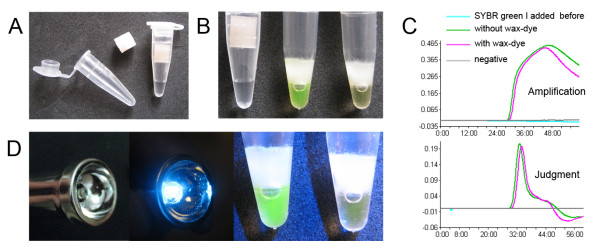Figure 1.
Using microcrystalline wax-dye capsule in LAMP detection. (A) Dye contained within a microcrystalline wax capsule; there is no contact between the wax and the LAMP mixture before amplification. (B) After isothermal amplification the capsule remains intact, and the dye was released by melting at 95°C; positive tube shows bright green, negative is orange, while cooling wax turns into solid barrier. (C) The LAMP reaction was monitored by a real-time turbidimeter, amplification and judgment curves of tubes with capsule added are similar to those without capsules, and the addition of SYBR Green I directly to the reaction prior to amplification completely inhibited the reaction. (D) A modified household flashlight with one 475 nm LED, and the result of blue light excitation.

